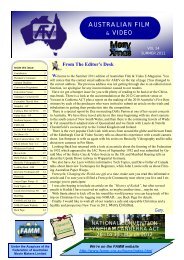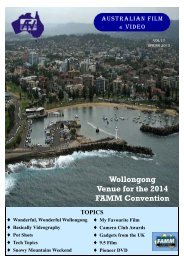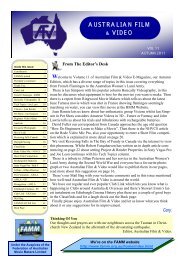Australian film - Federation of Australian Movie Makers
Australian film - Federation of Australian Movie Makers
Australian film - Federation of Australian Movie Makers
You also want an ePaper? Increase the reach of your titles
YUMPU automatically turns print PDFs into web optimized ePapers that Google loves.
TELECINE TRANSFER<br />
By John Sirett<br />
SOME BACKGROUND TO TELECINE<br />
There are, loosely speaking, three classes <strong>of</strong> Telecine Transfer which I will<br />
describe, for the want <strong>of</strong> better names, as follows:-<br />
(1) Fully Pr<strong>of</strong>essional:<br />
Top <strong>of</strong> the range, involving very expensive specialised equipment like the “Rank Transfer”, computerised<br />
“Flying Spot Scanning” <strong>of</strong> individual <strong>film</strong> frames, “Wet Gate” techniques to disguise <strong>film</strong> scratching, extensive electronic<br />
picture corrections and etc.<br />
Video laboratories having this equipment <strong>of</strong>fer their services to the public at a hefty hourly rate.<br />
( Typical firms have the ‘Rank Cintel 3’ machine. Their charge rate is, or was, from about $250 per hour lab working<br />
time, -- not <strong>film</strong> running time)<br />
(2) Semi-Pr<strong>of</strong>essional methods:<br />
(a) Involving direct optical viewing <strong>of</strong> the <strong>film</strong> frame with special and/or supplementary lenses attached to a<br />
camcorder focussed directly on the <strong>film</strong> in the projector's gate. (This method requires re-working <strong>of</strong> the projector's<br />
lamp installation) Can be done as a DIY project, but not easily. I tried, but could not make it work with the close-up<br />
lenses I have.<br />
(b) Dedicated “Telecine” machines operating on the same principle as in (2a) and made specifically for the<br />
purpose. I have not used one <strong>of</strong> these, but I have seen the resulting video which can be very good indeed.<br />
(For anyone interested, models I see mentioned on the internet are : PanasonicWV-J20N, Goko TC-20,<br />
Elmo TRV-S8, Fumeo 9131, Sony BM2100. Ballpark prices range from $US500 to $US1500 on E-Bay.)<br />
(3) The D.I.Y. methods:<br />
(a) Using a small box called a “TELECINE CONVERTER” having a lens, a front-silvered mirror and a<br />
ground glass screen. You play the projector into the lens <strong>of</strong> the box and focus the picture on the small ground glass<br />
screen. Then record with your camcorder focussed on this screen.<br />
I tried one <strong>of</strong> these some years ago and found it quite useless. The small ground glass screen is too refractive,<br />
making it impossible to obtain a clear, sharp image. (They cost about $50 to $80 as I recall)<br />
(b) THE “OPTICAL SCREEN” METHOD, which anyone can do, and being a DIY enthusiast myself,<br />
the method I adopted.<br />
The basic principle involves simply playing your projector picture on to a suitable screen and at the right<br />
speed, then recording it <strong>of</strong>f that screen with your video camcorder, for future showing or for subsequent video editing.<br />
Simple, isn’t it!<br />
TELECINE TRANSFER THEORY<br />
(For Super 8 silent <strong>film</strong>) (PAL System)<br />
MEETING THE SYSTEMS SPECIFICATIONS<br />
There are two major requirements that must be considered:<br />
(1) One involves elimination <strong>of</strong> the objectionable pulsating ‘flicker’ that is so <strong>of</strong>ten seen to accompany a<br />
telecine transfer. This is <strong>of</strong> paramount importance.<br />
(2) The other is how to manage the difference <strong>of</strong> frame rates (frames per second) between the original <strong>film</strong> and<br />
the television system.<br />
ELIMINATION OF FLICKER<br />
In the PAL system, video operates at 25 frames (50 fields) per second, while super 8 silent <strong>film</strong> is shot at<br />
18 frames per second. Immediately, we can see that there is conflict between the two systems.<br />
Because the 240V power supply alternations (Hz) sets the timing <strong>of</strong> the TV fields and frames and cannot be<br />
altered, every other operation <strong>of</strong> telecine transfer has to comply with this.<br />
<strong>Australian</strong> <strong>film</strong> & video<br />
Page 53










